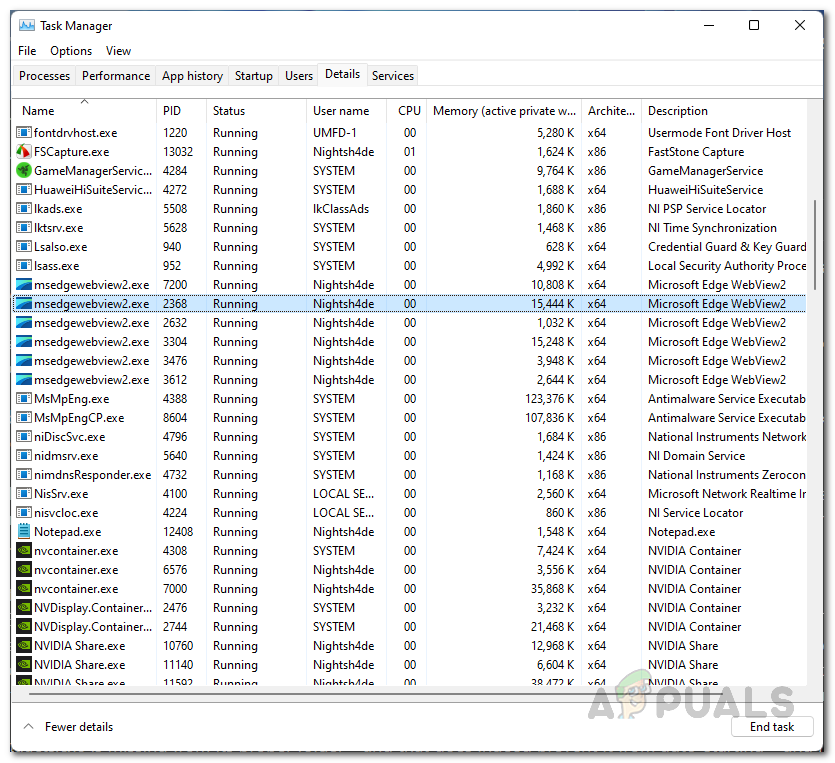As it turns out, Microsoft Edge WebView2 is essentially used to embed web pages in your native applications. Thus, this is used in the widgets app to show you the news stories as well as the Microsoft teams for different purposes. If you are not an avid user of both of these applications, the memory being used goes to nothing in which case the obvious option would be to reclaim the memory back. If you open up the Task Manager window on your system, you will often find several instances of the MSEDGEWEBVIEW2.exe process running that are being used by the mentioned apps. There are different ways you can resolve this problem from uninstalling Microsoft Teams to using a third-party utility to remove the WebView2 application. With that said, let us get started and show you how to get your memory back.
Close Microsoft Teams and Widgets from Task Manager
The first thing that you should do when you encounter this is to go ahead and end any processes of Microsoft Teams and Widgets. The MGEDGEWEBVIEW2.exe process is used by both of these apps primarily which is why you may see a bunch of instances of the said process. This is not a permanent fix as the same behavior will be back on the next reboot. However, for those that want a quick workaround, then this should be your goto option. To do this, follow the instructions down below:
Disable Microsoft Teams on Startup
Like we have mentioned, the above method is not a permanent fix as the processes will be back the next time you reboot your computer. If you are not one who often reboots their computer, then the method is well and good for you. However, to address most of us who reboot their systems on the daily, there is a better workaround to the dilemma here. As it turns out, another remedy to this is to simply disable Microsoft Teams on startup. By doing this, even when you restart your computer, Microsoft Teams will not startup automatically which is contrary to the default behavior. This means that you will have fewer msedgewebview2.exe processes to worry about. To do this, follow the instructions given down below:
Disable Windows Widgets using Windows Registry
Now, since the Microsoft Edge WebView2 process is used by Windows Widgets as well, we need to do something about that as well. As it turns out, even if you use the conventional methods of removing the Widgets icon from the taskbar, the app still runs in the background, eating away your memory. This means that when you perform a restart, the app will still be there running in the background and thus you will have to deal with the msedgewebview2.exe processes again. In such a case, the best solution is to turn it off for good using the Windows Registry. Before we proceed, if you are not really a power user, we would recommend creating a backup of the Windows Registry in case something goes wrong. With that said, follow the instructions given down below to do this:
Uninstall Microsoft Edge WebView2 via Third-Party Utility
Finally, if you wish to completely get rid of Microsoft Edge WebView2 and the annoying processes that run in the background, you can do so by simply uninstalling it from your computer. The problem here is that you will not be able to uninstall it using the conventional methods of using the Control Panel or the Windows Settings app. In such a scenario, we will be using a third-party utility called Revo Uninstaller which comes with both a Pro and Free plan that you can use to get rid of Microsoft Edge WebView2. To do this, follow the instructions that are given down below:
What is MSEdgeWebView2.exe? How to Fix It’s Issues?Fix: Host Process for Windows Service Consuming Internet BandwidthFix: Google Play Services Consuming Abnormal Battery LifeAMD Genoa EPYC 9334 Leaks Out, Performs Better than Intel Xeon Platinum’s Best…












